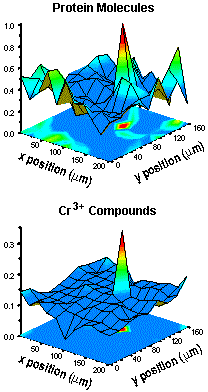| BERKELEY, CA — Seventy-five meters
beneath the surface of a site in Idaho where radioactive waste has been stored
for more than 40 years, microorganisms living in the pores and crevices of dry basaltic
rock are able to reduce a toxic form of chromium to a much less toxic form -- and they do
so faster in the presence of volatile organic wastes. Hoi-Ying Holman and her
colleagues Dale Perry, Michael Martin, Wayne McKinney, and Jennie Hunter-Cevera of the
Department of Energy's Lawrence Berkeley National Laboratory made the discovery by
examining core samples from beneath the Radioactive Waste Management Complex at DOE's
Idaho National Engineering and Environmental Laboratory. By using infrared
spectromicroscopy at Berkeley Lab's Advanced Light Source (ALS), they were able to follow
the reduction of toxic metals among populations of living organisms on minerals for the
first time. The researchers will discuss their findings in the forthcoming
October/November issue of Geomicrobiology Journal.
 |
 SPATIALLY RESOLVED INFRARED SPECTROSCOPY OF A
BASALT SURFACE SHOWS A STRONG CORRELATION BETWEEN CONCENTRATIONS OF BIOLOGICAL MOLECULES
CHARACTERISTIC OF MICROBES (TOP) AND PEAK CONCENTRATIONS OF REDUCED CHROMIUM (BELOW).
|
"We have shown that organic vapor may accelerate the transformation of mobile,
toxic chromium pollutants into less mobile, less toxic, stable compounds," says
Holman, a chemist and engineer with Berkeley Lab's Earth Sciences Division and the Center
for Environmental Biotechnology (CEB). "This should help in the design and
implementation of new, environmentally benign remediation techniques for cleaning up mixed
waste sites."
The Idaho site is polluted with mixtures of hexavalent chromium and other inorganic
ions, radionuclides, petroleum hydrocarbons, and volatile organic compounds. Hexavalent
chromium (Cr6+) is carcinogenic, mutagenic, and highly toxic to living organisms because
it occurs in soluble chromates that readily cross cell membranes. Once inside the cell,
these ions are reduced (electrons are added) first to pentavalent chromium (Cr5+), then to
trivalent chromium (Cr3+), which disrupts DNA replication.
Outside the cell, however, trivalent chromium is much less toxic, because it is
insoluble and can't cross cell membranes. "Polyvalent metal ions at this and other
polluted sites are reduced on the surfaces of geologic materials -- that's been known for
some time," Holman says, "but there were two views of how this happens."
The dry Columbia River basalts are limited in organic carbon and other nutrients,
Holman says, but dense clusters of microorganisms live in the pores and fractures of the
rock. "When water infiltrates from rain or melting snow, a burst of nutrients reaches
them through fissures in the rock, and they bloom like flowers in the desert" --
suggesting that microbes might play a role in metal-ion reactions.
It was uncertain which microorganisms might be involved in a biological reduction
mechanism and what metabolic processes were important, however. An alternate,
chemical-mechanism hypothesis proposed that metal oxides such as iron oxides in basalt
could help catalyze reductions with no help from living microbes.
To determine which mechanism was at work, Holman and her colleagues obtained basalt
core samples beneath the site from the unsaturated rock above the water table. From these,
Tamas Torok, a CEB microbiologist with the Lab's Life Sciences Division, isolated and
purified 85 strains of microorganisms, many tolerant of hexavalent chromium and able to
reduce it -- especially in the presence of toluene (C7H8), another of the site's
contaminants, which is a common product of leaking fuel tanks.
These chemical reactions typically proceeded through one or more steps, and many of the
organisms encountered bottlenecks that slowed the process. One strain of bacteria, Arthrobacter
oxydans, emerged as the most effective.
Arthrobacter oxydans tends to concentrate in areas rich in magnetite, an
iron-oxide compound common in basalt; the researchers had to eliminate the possibility
that the magnetite itself was responsible for the reduction. They tested to see if
reactions would proceed on sterilized magnetite under realistic environmental conditions:
in an aerobic atmosphere, at room temperature, and in the dark.
Arthrobacter oxydans was reintroduced on some of the sterilized magnetite
samples. Dilute chromate solution was applied to both the abiotic (barren) and biotic
(inhabited) magnetite samples; in a separate set of tests, the samples were also bathed in
a tenuous vapor of toluene.
Working on the ALS's infrared beamline over a five-day period, the researchers applied
Fourier-transform spectromicroscopy to observe the steps in the reduction process and the
precise location of reduced chromium.
"The infrared is the end of the spectrum not usually associated with
synchrotrons," says Holman, "but for us it's perfect -- and not only because
it's nondestructive of organisms. You have an extremely complicated spectrum in the
ten-micrometer region," which is the dimension of the beam. "We identified
markers in this spectral region that tracked the key compounds that undergo changes. We
could resolve the spectrum in time, to follow the different steps of the reduction, and
also in space, to see exactly where the reactions were happening."
On the samples with no living bacteria, no changes were evident. On samples with living
Arthrobacter oxydans, in the absence of toluene, chromium reduction was weak.
But where Arthrobacter oxydans had been exposed to toluene, infrared
spectromicroscopy showed that hexavalent chromium and toluene had been replaced by
pentavalent chromium and products of hydrocarbon degradation, in association with
biomolecules -- right where the bacteria were concentrated.
Was this microbial reduction an accurate reflection of what happened at the waste site?
"We now needed to study natural communities in the basalt," Holman says, and to
do so she had to devise a unique diamond saw that could cut thin slices from fresh basalt
cores, slowly, at cool temperatures, under aseptic conditions.
Over a period of four months the slices of native rock, with their resident communities
of microbes still in place, were exposed to solutions of hexavalent chromium and toluene
vapor. At first, infrared spectromicroscopy showed no evidence of reduction, and it
appeared that many of the organisms were dying. But after four months, chromium-tolerant
and chromium-reducing natural microorganisms were seen to be thriving -- in association
with trivalent chromium.
Says Holman, "As far as we know, this is the first time that infrared synchrotron
studies have been used to follow the steps in the transformation of toxic chromium on
mineral surfaces."
The Berkeley Lab is a U.S. Department of Energy national laboratory located in
Berkeley, California. It conducts unclassified scientific research and is managed by the
University of California.
Additional Information:
|

